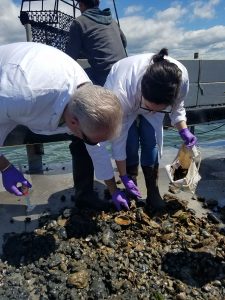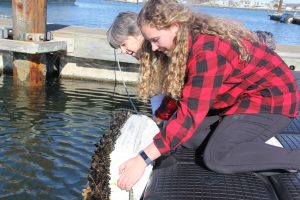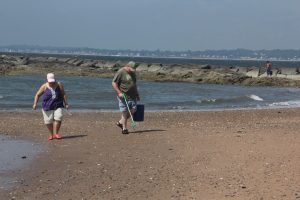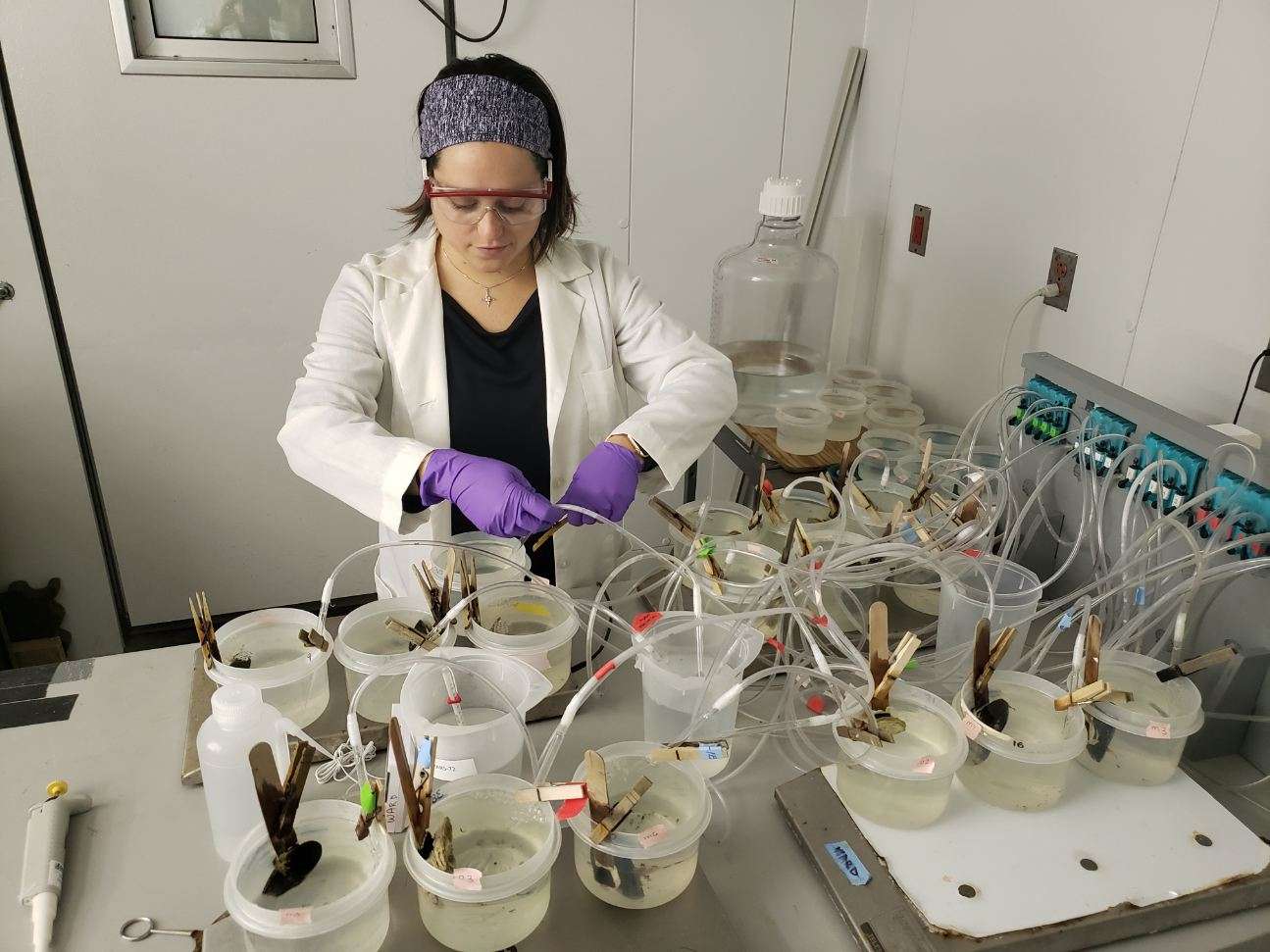Editor’s Note: this story was originally published in the Spring-Summer 2020 issue of Wrack Lines, the magazine of the Connecticut Sea Grant College Program, located at UConn Avery Point.
Love-hate relationships are tricky. They’re vexing. They’re complicated.
So it is between humans and plastic. Made primarily from petrochemicals derived from fossil fuels, the various forms of plastic are everywhere in our daily lives. They’re in our cars, our schools, our computers, our clothing and the air we breathe as fragments of synthetic fibers go aloft.
“We’re not going to get rid of all plastic,” said J. Evan Ward, professor and head of the UConn Marine Sciences Department. “Plastics have made our lives better. What we need to do is identify the ones that are most problematic, the ones that have the possibility of being transported up the food chain.”
Examples of beneficial plastics leap to mind readily. Think of artificial joints that restore mobility, plumbing pipes that don’t corrode, lighter vehicles that reduce fuel consumption and eyeglasses that resist breakage. All have clear advantages over the metal, ceramic and glass counterparts they replaced.

But plastic has a dark side, too, particularly in the marine environment where Ward focuses his research. With an estimated 8 million metric tons of plastic getting dumped into the sea annually, harmful impacts of plastics and its persistence in the environment are becoming ever more apparent. Photos of seals being strangled by monofilament fishing line, a turtle with a straw stuck in its nostril and dead seabirds with stomachs blocked by trash serve as poster children prompting public disgust and action to reduce the use of throwaway plastics. The Ocean Conservancy calculates there are already 150 million metric tons of plastic in the marine environment.
“It’s overwhelming for the masses, when you start to look at the big picture and try to make sense of it,” said UConn Marine Sciences Professor Sandra Shumway, now in her third year of collaborating with Ward on research involving plastics. Specifically, their work focuses on microplastics, those microscopic bits frayed from larger pieces, and their effects on shellfish.
“There is nowhere that has escaped the presence of microplastics,” she said. “They’re even found in caves in the deep ocean, in the Arctic and Antarctic.”
Concern about plastics isn’t limited to academia, though. As the call from environmental groups to curb single-use plastics became mainstream, a movement to ban plastic shopping bags gained momentum. Last year, Connecticut joined seven other states in enacting it, although the ban was lifted during the pandemic. Individual Connecticut communities have also banned items such as plastic straws, stirrers and take-out containers.
Mystic Aquarium is among the groups supporting these changes. After years of sponsoring beach cleanups and rescuing seals, turtles and other marine animals from entanglement in plastic debris, the aquarium took its campaign to the next level. It set aside part of its exhibit space to further public awareness about the problem. Opened in April 2019, “Plastic Free Seas,” is likely to remain a permanent exhibit, tucked between tanks of blue angel fish, Caribbean blue tang and green moray eel.
Specially lit tanks illuminate microplastic particles to enable visitors to see them for themselves, allowing them to trap a plastic bag and floating water bottle in a net while the gossamer fragments float free. But rather than focus exclusively on the problem, the exhibit suggests ways people can be part of the solution – switching to non-plastic alternatives, for example, as well as participating in beach cleanups. One panel tells the story of a local woman who’s trained her service dog to pick up plastic when she and her son do beach cleanups. Instead of conveying an oversimplified message that all plastic is bad, it encourages people to differentiate between reusable plastic equipment and throwaway single-use items they could skip altogether.

“It’s a bigger problem than we can solve by just doing beach cleanups,” said Dale Wolbrink, spokeswoman for the aquarium. “It’s about stopping it at the source.”
To spread the word further, the aquarium has taken the message on the road. Dozens of schools, farmers markets, yacht clubs, beach communities and other venues have hosted aquarium educators for lessons about the scope of the plastic problem and ways to curb it.
“We’re focusing on the idea of refuse, reuse and reduce before recycling,” said Mary Ellen Mateleska, director of education and conservation at the aquarium. “We’re trying to get the message out that solving the global problem of plastic pollution can begin with you.”
In the summers of 2018 and 2019, the aquarium joined the Long Island Sound Study and Connecticut Sea Grant in leading a “Break the Single-Use Plastic Habit” campaign, launched both years with trash pickups at public beaches.
Judy Preston, Long Island Sound outreach coordinator for Sea Grant, said the campaign has effectively used social media – including the hashtag “#DontTrashLISound” – to draw attention to the plastic problem specific to the estuary. Oystercatchers, seals, black fish and other Long Island Sound wildlife are depicted on attractive decals for reusable water bottles and travel mugs given out as part of the effort.
“Bringing attention to the plight of seals, sea birds and even the less familiar terrapin that is threatened from habitat loss and degradation due, in part, to plastic debris, is a way to help people understand that plastic can have a life of its own long after it’s ‘disposed of,’” she said. “Coupled with the International Coastal Cleanup Day in September, the #DontTrashLISound campaign has resulted in the removal of thousands of cigarette butts (the most collected item), food wrappers, plastic caps and bottles, and the often cited plastic straw.”
The groups involved in the campaign hope to continue the momentum around the problem of plastic debris, she said.
“Legislation to ban or curtail its use is hopeful,” she said. “If we can collectively make a difference in this arena, perhaps we can gain momentum for other important sustainability issues to help Long Island Sound, such as reducing our fertilizer use and driving less.”
Ward and Shumway both applaud cleanups of the plastic littering beaches and waterways and efforts to encourage people to use less plastic. In their view, helping to rid the environment of the discarded bags, empty take-out cups and similar large pieces of plastic trash are where the main work of engaging the public about plastic pollution belongs.
“There is definitely good reason to reduce the amount of plastic in the environment,” Ward said. “We should get rid of all nonessential plastics. There are definitely some serious problems with animal health and plastics.”
Acting to reduce plastic use overall, Ward said, is equivalent to first turning off the faucet when the tub overflows, before grabbing a bucket to start bailing. He and Shumway lament that some recently published popular and academic reports have fed generalized anxiety about all plastics that can leave people feeling powerless and directionless about how to effectively respond. Instead, the two researchers are hoping their work will reveal which particular parts of the plastic problem should — and shouldn’t — be the focus of concern. Too much emphasis on the wrong area, they fear, will dilute energy from where it’s really needed.
“There’s no point in upsetting the general public for no good reason,” said Shumway.

She was referring to concerns being raised that oysters, clams and mussels — shellfish that are commercially important, healthy sources of protein — were ingesting microplastic particles, which would in turn get eaten by humans. With seven decades of work on shellfish between them, she and Ward have a deep understanding of shellfish physiology and good reason to suspect the threat was being overblown.
Working with doctoral student Kayla Mladinich and more recently with graduate student Hannah Collins, the two researchers began the project three years ago by tracing the path of microplastics through the guts of mussels.
This is meticulous work involving some very time-consuming processes to study effects of long-term plastic exposure, and others requiring great precision to gauge short-term impacts. In the earlier field sample collection phase of the project, where sediment, water, oyster tissue and other marine materials are gathered and analyzed, the researchers had to be hypervigilant to prevent samples from getting contaminated with airborne microplastics. The study has also involved the use of a needle-sized endoscope to film the bivalves’ internal digestive organs as they were fed plastic particles.
Results thus far show the mussels reject nearly all of the microplastics, either spitting them out as they first enter their systems, ejecting them at their filtering organs, or excreting them in feces.
“This shows people that bivalves are not good indicators of microplastics in the environment,” Shumway said.
The current phase of the project, funded by Connecticut Sea Grant and the National Oceanic and Atmospheric Administration, is looking at the types of plastic used in the nets, ropes, cages and other equipment of aquaculture farmers. Are shellfish eating particles fraying off the gear and incorporating them into their tissue? If so, which types in particular? A second line of inquiry asks whether the makeup of the bacterial community in shellfish digestive organs is changing in response to plastics.
“What we’re trying to figure out is how oysters and mussels exposed to environmentally relevant microplastics, like nylon and polyester microfibers, select particles for ingestion,” Mladinich said. The different shapes, sizes and composition of various particles are all determinants of what happens in shellfish, she said.
With so much attention being paid to plastics these days, she and Collins both feel privileged to be young researchers involved in a project with immediate relevance. But it can also be daunting, considering the global scale of plastics problem.
“Sometimes it does seem overwhelming, when you think of the size of the problem,” Collins said. “But even though it feels overwhelming, I appreciate knowing that I’m working on one piece of it.”
Ultimately, Ward said, the purpose of the research is to take a mindboggling unknown – the full extent and impact of plastics in the marine environment – and break off one piece into an answerable question.
“We’re developing a model to identify which microplastics are ingested by bivalves and which are rejected,” he said. “The types are a consequence of the particle size and shape. We’d like to be able to tell managers which types of microplastics are most problematic for bivalve gear” so that shellfish farmers can avoid using it.
Thus far, though, theirs is a “good news story” for the shellfish industry, Ward and Shumway said. While other research may be raising “danger” signs about shellfish safety, their results are showing that people aren’t eating plastic when they slurp an oyster at their favorite raw bar.
“There’s been some bad science about this,” Shumway said. “People have been using this bandwagon to further their own cases to link microplastics to human health issues of eating shellfish, and it’s just not right. Shellfish are a good, safe source of protein, they’re good for the economy, good for the environment and they’re good for you.”
STUDENTS RELATE TO LESSON IN THE REAL-LIFE PROBLEMS, SOLUTIONS TO TOO MUCH PLASTIC
East Lyme – Quickly the class of eight- and nine-year-olds rattled off what they’d found on beach clean-ups.
“Dirty diapers in the bushes,” said one boy.
“Cigarette butts in the sand,” said another.
“A lot of plastic water bottles,” added a third.
“And what do you know about plastic?” asked Mary Ellen Mateleska, their guest teacher for the morning lesson.
“It never breaks down,” said one girl.
These third graders, gathered in the library and Niantic Center School one day last winter for a traveling program about plastic from Mystic Aquarium, live in a shoreline town where cleanups at local beaches are part of growing up. Clearly they made for a receptive audience for information about how plastics harm turtles, seals and seabirds, and how much is getting into the marine environment.
Mateleska, working with co-teacher Ireland Wilson, listed some of the items most commonly collected in beach clean-ups: plastic bottles, food wrappers, bottle caps, plastic straws and stirrers. After showing a short film of aquarium staff leaning off the edge of a boat to cut a loggerhead turtle free from plastic netting, they taught the students the four R’s: Refuse first. Then reduce, reuse and lastly, recycle.
“We could all just make one change and not use so much plastic,” she told them. “I’m going to ask you guys to make a pledge to stop using single-use plastic.”
But before signing the pledge – a banner the students signed with colored markers and a phrase or picture – they got a hands-on lesson – literally – in what marine animals can experience when they encounter plastic.
Five student volunteers stood in front of the class as Wilson and Mateleska placed a rubber band around their outstretched fingers. They were told to work it off using only that hand, mimicking the predicament of animals with flippers. The students giggled and grimaced as they contorted their bound hands every which way. Only one managed to work off the rubber band.
“This issue is on the minds of kids from elementary school to high school to college,” said Mateleska. “It’s a hot topic right now, so we’ve been trying to get out there as much as we can.”
-Judy Benson



